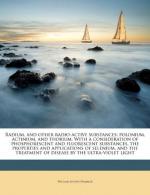|
This section contains 363 words (approx. 2 pages at 300 words per page) |
Thorium is an actinide series, rare earth element denoted by the atomic symbol, Th. It has an atomic number of 90 and the average atomic weight of its isotopes is 232.0381. It is a grayish-white, radioactive metal that is slightly malleable. It has a melting point of 3182°F (1750°C) and a boiling point of 8650.4°F (4788°C).
The first announcement of the discovery of thorium came in 1815. Jöns Berzelius reported that he had found a new element in a mineral taken from the Falun district of Sweden. He named the element thorium after the Scandinavian god Thor. A decade later, however, he found out that the substance was not a new element at all, but the compound yttrium phosphate.
Still later, in 1829, Berzelius once again reported the discovery of a new element. He found the element in a mineral sent to him for analysis by the Reverend Hans Esmark. This time Berzelius had made no error. The mineral did contain a new element for which he once more suggested the name thorium.
That fact that thorium is radioactive was not discovered until 1898. In that year, just after the discovery of radioactivity itself, English chemist Gehard C. Schmidt and Marie Curie independently announced that thorium was radioactive.
The element is thought to have an abundance of about 15 parts per million in the earth's crust, many times greater than that of uranium. The energy produced by the radioactive decay of these two elements is thought to be responsible for the earth's internal temperature. The energy stored in the earth's thorium reserves is thought to be greater than that available from all other conventional (fossil) and nuclear fuels combined.
For that reason, thorium has considerable potential as a nuclear fuel. When struck by neutrons, thorium-232 is converted into uranium-233, one of the few fissionable isotopes known.
The most common use of thorium today is in the manufacture of Welsbach mantles used in portable gas lanterns. When heated with a gas flame, a Welsbach mantle emits a brilliant white light. Thorium (IV) oxide is also used in the manufacture of high quality glass, lenses, and as a catalyst in various industrial processes.
|
This section contains 363 words (approx. 2 pages at 300 words per page) |


